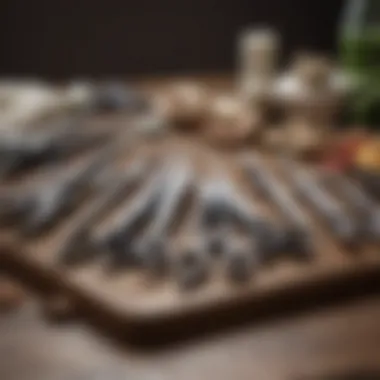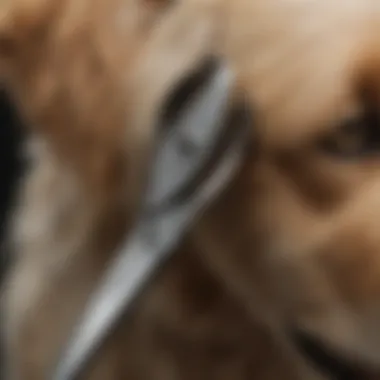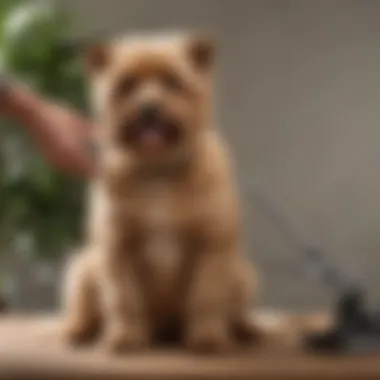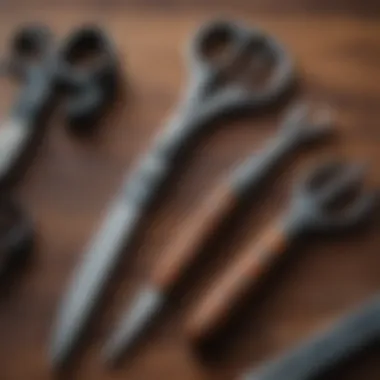Comprehensive Guide to Professional Dog Shears


Intro
In the world of dog grooming, professional shears play a pivotal role. Not just ordinary scissors, these tools are designed with precision for specific grooming tasks. Understanding their components, types, and uses can greatly enhance the quality of grooming services. This guide offers insights into professional dog shears, which are essential for both novice and experienced groomers. With proper knowledge, one can ensure the aesthetics and hygiene of pets, contributing to their overall well-being.
Overview of Professional Dog Shears
Professional dog shears are available in various types, each crafted for distinct grooming tasks. They differ not only in design but also in the materials used. Some shears are meant for detail work, such as trimming the hair around the face and paws, whereas others may be created for efficient body clipping. Understanding these distinctions is crucial when selecting the right pair for your specific grooming needs.
Types of Professional Dog Shears
- Straight Shears: Ideal for general grooming needs, straight shears are versatile and commonly used. They provide clean cuts and can be used on various coat types.
- Curved Shears: These shears allow for seamless blending around limbs and contours of the dog's body. Their design makes them perfect for achieving rounded finishes.
- Thinning Shears: Thin out thick coats by blending, allowing for a more natural appearance. They help in reducing bulk without losing length.
- Facial Shears: Smaller and designed for detail work, facial shears are perfect for sensitive areas around the eyes and ears.
Material Composition
The material of the shears significantly impacts their performance. High-quality professional dog shears are typically made from stainless steel or carbon steel. Stainless steel offers corrosion resistance, making it durable for long-term use. Carbon steel shears, while prone to rusting, can remain sharper longer. Selecting the appropriate material is essential, as it can affect the ease of use and the final results.
Features to Consider
When selecting dog shears, several factors should guide your decision:
- Ergonomics: Comfortable grip ensures better control and reduces hand fatigue. Look for shears that are easy to hold and operate.
- Blade Size: Blade length should match the grooming task. Smaller blades work better for detailed areas, while longer blades can be suitable for larger sections.
- Finishing: The finish on the shears (matte vs. shiny) can affect grip and handling. Matte finishes tend to reduce glare, which can be beneficial.
- Price Point: Investing in quality shears may be more cost-effective in the long run. Expensive shears often maintain sharpness and durability better than cheaper alternatives.
“Choosing the right professional dog shears is fundamental for successful grooming outcomes. The tool is only as good as the skill behind it, but it can certainly enhance that skill.”
Maintenance Techniques
Maintaining your dog shears is critical for their longevity and effectiveness. Here are some helpful tips:
- Cleaning: Always clean the blades after use to remove hair and debris. This reduces the risk of contamination.
- Sharpening: Regularly sharpen the blades to maintain a clean cutting edge. Dull blades can lead to uneven cuts and stress the dog's coat.
- Lubrication: Apply a drop of oil to the pivot point to keep shears functioning smoothly. This prevents rust and promotes durability.
- Storage: Store your shears in a protective case or a designated area. Avoid storing them unprotected, as this can lead to damage or dulling.
Closure
Professional dog shears are indispensable tools in dog grooming. Their various types and features cater to different grooming tasks. Understanding what to look for when selecting shears can greatly enhance grooming results. Moreover, routine maintenance ensures the longevity and efficiency of these tools. A well-groomed dog is a happy dog. Through proper care and usage of professional shears, groomers can enhance their skills and contribute positively to the well-being of their furry clients.
Preface to Professional Dog Shears
Professional dog shears are vital tools in the grooming industry. Understanding their features and benefits can significantly improve the outcome of pet grooming. This section emphasizes how the right shears are not just about aesthetics but also about the animal's comfort and care.
The Role of Shears in Dog Grooming
Shears serve a fundamental purpose in grooming practices. They allow groomers to create clean, precise cuts, ensuring that a dog's coat is healthy, manageable, and looks appealing. Quality shears can help avoid issues such as mats or tangles that may lead to discomfort for the dog. Efficient grooming can also contribute to the dog's overall well-being. Properly trimmed fur can help with temperature regulation, particularly for breeds with long or thick coats.
Grooming shears can be used in various ways. For instance, straight shears often handle basic trimming tasks, while curved shears excel at shaping and creating softer looks. Thinning shears reduce bulk without affecting the length significantly, making them ideal for breeds that require regular maintenance. Every tool serves its individual role, enhancing the entire process of dog grooming.
Why Quality Matters
Quality shears are an essential investment for anyone serious about dog grooming. Cheaper, lower-quality tools might be tempting but can lead to problems over time. Dull blades cause stress and discomfort to the dog, leading to a negative grooming experience. This can manifest as uneasiness or even fear surrounding future grooming sessions.
High-quality shears maintain sharpness, providing clean cuts that are more pleasant for the dog. Furthermore, such tools tend to be more durable, allowing for less frequent replacements. Cost-effective grooming starts with investing in the right tools.
Key Considerations
- Look for shears made from premium materials like stainless steel or carbon steel for longevity.
- Consider ergonomic designs that provide comfort during long grooming sessions.
- Evaluate the maintenance requirements of the shears to ensure they remain in top condition.
Quality shears may cost more upfront, but they lead to better results and improved experiences for both the groomer and the dog.


Types of Professional Dog Shears
Understanding the types of professional dog shears is essential for any groomer or pet owner looking to provide optimal care for their animals. Each type of shear has its unique purpose and is designed to tackle specific grooming tasks. Selecting the appropriate shears can greatly influence the efficiency of grooming sessions and the comfort of the dog. It can also affect the overall appearance of the groom. Thus, this section aims to delineate the different types of professional dog shears, shedding light on their importance and intended uses.
Straight Shears
Straight shears are perhaps the most common type found in grooming kits. These shears have blades that run parallel to each other, allowing for precise cutting. Their main advantage is the ability to create clean, even cuts. They are ideal for trimming hair evenly and quickly on areas like the body, legs, and tails of dogs. Properly using straight shears involves holding theShears correctly, with one finger in the finger hole and the thumb on the moving blade to control the cutting action. Many groomers prefer straight shears for their versatility and they work well for both general and breed-specific grooming styles.
Curved Shears
Curved shears feature blades that arc rather than remaining straight. This curvature allows for a more natural grooming angle, especially when working around the face, paws, and tail. Curved shears are invaluable for creating shape and contour, giving the dog's natural form a more polished look. When using these shears, one can follow the contours of the dog's body more naturally. This makes them particularly useful for breeds with flowy coats that require sculpting. The curvature promotes better control and can minimize the risk of cutting too deeply into the fur.
Thinning Shears
Thinning shears are designed with teeth on one blade and a smooth edge on the other. The teeth allow for the removal of excess fur without altering the overall length. This is crucial for dogs that have thick or heavy coats. Thinning shears help to reduce bulk and prevent a choppy appearance. When employing these shears, it is important to use them sparingly. Over-thinning can lead to an unnatural look. They are an excellent choice for blending fur, helping to create a more cohesive groom that looks natural and well-maintained.
Chunkers
Chunkers, also known as texturizing shears, differ from thinning shears in that they have fewer teeth. They are designed to remove larger amounts of fur at once. This type of shear is beneficial for thick coats or for creating dramatic texture in a dog's fur. Chunkers can help achieve an artistic finish by layering and adding dimension to the coat. Similar to thinning shears, these should be used judiciously to ensure a balanced look. When used properly, chunkers can give a stylistic flair to a dog's overall grooming appearance.
In summary, understanding the specific types of dog shears allows groomers to select the right tools for the job. This makes grooming more efficient and can positively influence the dog's comfort level during the process. Each type of shear has its own strengths and ideal applications. By becoming familiar with these tools, groomers can enhance their skills and provide better care for their canine clients.
Materials Used in Professional Dog Shears
When choosing professional dog shears, the material used in the construction plays a critical role. It influences the effectiveness, durability, and usability of the shears. Understanding the differences between materials can aid groomers in selecting the right tools for their specific grooming tasks. Here we discuss three key materials commonly found in dog shears: stainless steel, carbon steel, and titanium coatings.
Stainless Steel
Stainless steel is known for its resistance to rust and corrosion. This quality makes it an ideal choice for grooming tools that are frequently exposed to moisture and cleaning products. The blades made from stainless steel are generally easier to maintain and clean, ensuring longevity in their performance. Groomers appreciate the consistent sharpness of solid stainless steel blades, which allows for smooth and precise cutting.
- Benefits of Stainless Steel:
- Durability: Resistant to rust and wear.
- Ease of Maintenance: Simple to clean and maintain.
- Consistent Performance: Retains sharpness over time.
Stainless steel shears are often a choice for both professional groomers and pet owners, as they combine practicality with effective grooming capability.
Carbon Steel
Carbon steel is another material that deserves attention in the realm of professional dog shears. Known for its hardness, carbon steel can be honed to achieve an extremely sharp edge. This exceptional edge retention is valuable for achieving detailed work on various dog breeds. However, carbon steel requires more care compared to stainless steel, as it is susceptible to rust if exposed to moisture without proper maintenance.
- Advantages of Carbon Steel:
- Sharpness: Holds a sharper edge longer than many stainless options.
- Workability: Easier to restore sharpness when dull.
Groomers experienced in handling this material tend to appreciate its responsiveness in cutting, particularly for precision work.
Titanium Coatings
Titanium coatings are becoming increasingly popular on dog shears. While the base material might be stainless steel or carbon steel, the titanium layer enhances durability and rust resistance. This layer can also contribute to a smoother cutting experience, as the surface reduces friction. By utilizing titanium coatings, manufacturers aim to extend the life of the shears while maintaining their effectiveness and sharpness.
- Key Features of Titanium Coatings:
- Enhanced Durability: Protects from wear and tear.
- Reduced Friction: Enhances cutting performance.
- Aesthetic Appeal: Often comes with an attractive finish.
Key Features to Consider When Buying Shears


When investing in professional dog shears, several key features must be evaluated. Choosing the right shears is crucial for effective grooming. The right tools can make the grooming process smoother, faster, and more efficient. This section focuses on significant elements that should guide your decision-making process when selecting shears.
Handle Design
The handle design of dog shears affects the overall comfort and grip during use. A well-designed handle accommodates the natural shape of the hand, which is important for long grooming sessions. Ergonomic handles can help prevent hand fatigue, making it easier to achieve precise cuts.
There are various handle styles, including:
- Offset handles: This design provides a more natural grip and can reduce wrist strain.
- Finger holes: The size and spacing of finger holes can greatly affect comfort. They should not be so tight that they cause discomfort, nor so loose that the shears are difficult to control.
- Soft or cushioned grips: These materials can provide extra comfort during use, allowing for better handling and control.
Blade Sharpness
Blade sharpness plays a vital role in the effectiveness of grooming shears. Sharp blades allow for clean and precise cuts, minimizing the risk of pulling or tearing the dog's hair. Dull blades can cause discomfort for the animal and require extra effort from the groomer. By ensuring that the blades are consistently sharp, you can improve both the aesthetics of the grooming job and the comfort of the pet.
When considering blade sharpness, keep in mind:
- Material quality: The steel's quality often determines how long the blade maintains its sharpness.
- Maintenance: Regular sharpening will be necessary, and some shear types can be easier to sharpen than others.
Weight and Balance
The weight and balance of dog shears are essential factors that influence handling. Shears that are too heavy can lead to fatigue during extended grooming sessions, while those that are too light may not provide the necessary control.
An ideal balance means that the weight is evenly distributed, allowing the groomer to control the shears with minimal effort. When evaluating the weight and balance:
- Test the shears: Hold the shears in your hand to gauge how they feel while mimicking grooming movements.
- Physical strain: Consider how long you plan to use the shears. Long grooming sessions require tools that feel comfortable in your hand to avoid strain and injury.
"The right balance in shears can enhance accuracy and minimize fatigue during grooming."
Choosing the Right Shears for Different Dog Breeds
Choosing appropriate shears for different dog breeds is critical for achieving desirable grooming results. Each breed has unique coat types, length, and texture, impacting which shears will be most effective. Understanding these differences not only improves the grooming experience but also promotes the comfort and well-being of the dog. Using the wrong tools can lead to frustration for both groomer and pet. Therefore, it is essential to match the shear type to the specific grooming requirements of a breed. A proper fit helps ensure ease of use and a final look that meets breed standards.
Grooming for Long-Haired Breeds
When grooming long-haired breeds, such as the Afghan Hound or the Shih Tzu, it's important to select shears that will help manage the volume and length of the fur. Straight shears are often preferred for trimming the ends, while thinning shears can reduce bulk without compromising length. This is especially useful for breeds with thicker coats. The use of curved shears may also be beneficial for shaping and finishing touches around the face and ears.
Regular grooming is vital for these breeds to prevent matting. Long-haired dogs often require a more delicate touch during grooming to ensure their comfort. Using blunt or dull shears can lead to painful pulling. As such, keeping blades sharp is essential.
Grooming long-haired breeds requires patience, precision, and the appropriate tools.
Grooming for Short-Haired Breeds
Short-haired breeds, like the Beagle and Boxer, typically require a different approach. These coats often demand less maintenance, but that doesn’t mean they don’t need proper attention. Straight shears can be effective for trimming around sensitive areas. However, primarily, the focus should be on regular brushing to maintain a healthy coat.
Utilizing chunkers can help blend and soften the coat's appearance, preventing a harsh look. Short-haired dogs may not require thinning shears as often since their fur doesn’t tangle like long-haired breeds. The goal is to maintain a clean and polished look while ensuring the process is efficient.
In summary, the correct choice of shears directly correlates with the type of dog and its grooming needs. Personal preferences for styles and techniques will play a role in decision-making as well.
Using Professional Dog Shears Effectively
Using professional dog shears effectively is essential for any groomer who seeks to achieve a high-quality grooming outcome. The right techniques not only enhance the overall appearance of the dog but also ensure the safety and comfort of the animal during the grooming process. Understanding how to correctly hold, maneuver, and utilize these tools plays a significant role in the grooming experience. Moreover, mastering these techniques can significantly reduce the risk of accidents and injuries, which is crucial for both the groomer and the pet.
Techniques for Safe Grooming
When using professional dog shears, it is important to follow specific techniques that prioritize safety. Here are some key pointers:


- Grip: Always ensure a firm grip on the shears. This helps maintain control and prevents slipping.
- Approach: Approach the dog calmly. Sudden movements can startle the animal, increasing the risk of accidents.
- Positioning: Position the dog securely but comfortably on a grooming table. A stable environment keeps both the groomer and the dog safe.
- Angle of Shears: Use the shears at an appropriate angle. This minimizes the chance of cutting skin or causing discomfort. Holding the shears flat against the dog’s body is often safer than using a steep angle.
- Slow Movements: Make slow, deliberate cuts. Rushing can lead to mistakes. Pay attention to the dog's reactions and adjust your technique as needed.
- Regular Breaks: Take breaks. Grooming can be stressful for dogs. Allowing them to relax can help maintain a positive grooming experience.
Here is a simple check list you can follow to maintain safety:
- Check for distractions in your workspace.
- Ensure all equipment is in good condition.
- Clean the shears before and after use.
- Use appropriate shears for the dog’s fur type.
Safety is the top priority in grooming, both for the pet and the groomer.
Common Grooming Styles
Professional dog shears can be used for various grooming styles, depending on the specific needs of the dog breed and the desired outcome. Here are some common styles:
- Teddy Bear Cut: This cut is popular among many breeds like poodles. It involves trimming the fur to achieve a fluffy appearance, making the dog look like a teddy bear.
- Lion Cut: Particularly common for cats, but can also be applied to certain dog breeds. This style leaves the head, mane, and tail fluffy while the body is clipped short.
- Puppy Cut: A uniform length cut usually performed on long-haired breeds. It gives a neat and easy-to-maintain appearance.
- Show Grooming: This style is often used for dogs that participate in competitions. It requires precise cuts to enhance the breed’s characteristics, sometimes requiring professional training.
- Functional Cuts: These styles focus on practicality and comfort, especially for working dogs. For example, a short cut in summer can help keep them cool.
Understanding different grooming styles helps groomers make informed decisions on using shears effectively. This knowledge enhances the grooming experience and ensures both safety and satisfaction for the pet owner.
Maintenance and Care for Dog Shears
Proper maintenance and care for dog shears is fundamental for ensuring their longevity and effectiveness. Grooming is not just about the artistry involved; it’s also about the tools used. Quality shears require attention to detail in their upkeep to perform optimally. Regular maintenance not only enhances the cutting performance but also protects the welfare of the dogs being groomed. Dull or dirty shears can cause discomfort or lead to injuries, making this topic critical for anyone involved in dog grooming, including veterinarians and families engaged in pet care.
Cleaning Methods
Cleaning dog shears after each use is imperative. Shears often gather hair, dirt, and skin oils that can hinder their performance. Here are some effective cleaning methods:
- Use a Soft Cloth: Wipe the blades gently with a soft cloth to remove hair and debris. This should be done after every grooming session.
- Brush Away Residue: A small brush, like a toothbrush, can be useful to remove hairs caught in the pivot point and between the blades.
- Disinfect the Blades: Use an alcohol wipe or a disinfectant spray to clean the blades thoroughly. This step is important to eliminate bacteria that might cause infections in pets.
- Oiling the Blades: Apply a few drops of shear oil to the blades to keep them lubricated. This not only enhances performance but also prevents rust.
Regular cleaning helps maintain razor-sharp blades and can drastically improve the grooming experience.
Sharpening Techniques
Sharp blades are essential for clean cuts and safe grooming. Dull blades can pull on the hair, which is painful for the dog and can lead to a bad grooming experience. Here are some sharpening techniques to consider:
- Use a Sharpening Stone: A sharpening stone can be an effective tool. Hold the shear at a 30-degree angle and slide each blade against the stone. Repeat this motion until you feel the blades are sharp enough.
- Professional Sharpening Services: If unsure about sharpening at home, consider sending shears to a professional. They have the expertise and tools to restore the edge properly.
- Honing Steel: For routine maintenance, a honing steel can align the blade’s edge. It is not a replacement for sharpening but can help in maintaining the edge between professional sharpenings.
Keeping shears sharp extends their life and ensures the comfort of the dogs.
Storage Solutions
Storing dog shears properly is another critical aspect of maintenance. Improper storage can lead to damage or dulling of the blades. Consider these storage solutions:
- Shear Cases: Invest in a quality shear case. This protects them from dust and accidental damage.
- Separate from Other Tools: Do not store shears with other grooming tools that could cause scratches or dents.
- Humidity Control: Store shears in a dry, cool place. Excess humidity can lead to rust, which harms the blades.
Good storage practices promote the longevity and performance of professional dog shears.
In summary, regular maintenance, proper cleaning, sharpening, and effective storage are essential for the longevity of dog shears. These practices ensure the shears remain functional and safe, benefiting both groomers and the pets they care for.
Ending
In this article, we have explored the intricate world of professional dog shears, which play a critical role in effective dog grooming. Quality shears directly influence the efficiency of grooming tasks, ensuring safety and comfort for both the groomer and the dog.
Recap of Key Points
It is essential to consider the following elements when selecting and using professional dog shears:
- Types of Shears: Understand the differences between straight, curved, thinning shears, and chunkers, as each has unique applications based on the dog's coat type and grooming style.
- Materials: The shears' construction materials significantly affect durability and performance. Stainless steel, carbon steel, and titanium coatings offer varying benefits.
- Features: Key features like handle design, blade sharpness, weight, and balance are vital in ensuring a comfortable grooming experience.
- Maintenance: Proper care, including cleaning, sharpening, and storage, prolongs the life of shears and maintains their effectiveness.
Final Thoughts on Investing in Quality Shears
Investing in high-quality dog shears is more than just a purchase; it is an investment in the well-being of your pets. Good tools lead to better grooming results, enhancing the overall experience for both the dog and groomer.
In summary, selecting the right shears demands attention to detail and understanding of the grooming needs of different breeds. Quality and maintenance should not be overlooked, as they contribute significantly to achieving professional results. A thoughtful choice in dog shears can transform grooming from a mundane task into an enjoyable ritual.







